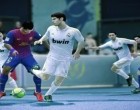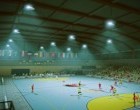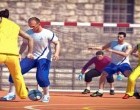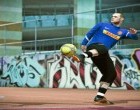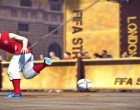مراجعة FIFA Street
بينما قامت Duke Nukem Forever و الحديثة Syndicate بالعمل جاهداً لتثبت أن اعادة التشغيل شيء مرحب به أيضا تقوم Deus Ex و SSX لإثبات ذلك. اذاً اين هي FIFA Street من كل هذا؟
دعني أقول لك أن هنالك حوالي 1000 محاولة اقتراب من قبل EA في مجال سلسلة كرة القدم تركز على حالة الواقعية في اللعبة. هي ليست لعبة في الفيزياء المعقدة, أو رسوم متحركة بسيطة. في الحقيقة هي لعبة مغروسة في واقع كرة قدم الشارع حيث يستخدم مطور اللعبة الأجزاء الداخلية من لعبة FIFA 12 لابتكار شيء أكثر متعة.

من اللحظات الأولى من لعب FIFA Street تستطيع أن تلاحظ الفرق الشاسع. لم تقم اللعبة من التخلص من رسوماتها ذات الطابع الكاريكاتوري فحسب بل و حصلت على تعديل كبير ايضاً. استطاعت عن طريق استخدام محرك Impact جعل الاعبين يتحركون بطريقة تصادم واقعية في الحقيقة تبدو مألوفة جدا لدرجة أنني تخيلت لعب FIFA 12.
التركيز الأساسي في اللعبة هو على استخدام الحيل و الأساليب المختلفة للقيام بإحداث مكان كاف للقيام بالتمرير. تستطيع عن طريق استخدام المقبض اليميني بالقيام بالحيل و استخدام L1 للقيام بالأساليب الختلفة للتصويب و الاطلاق و التمرير بينما يتيح لك خيار L2 شيئا جديدا. يعرف بإسم Street Ball Control يسمح لك بإيقاف الاعب و اللعب بالكرة عن طريق المقبض اليساري. يجعلك هذا على تواجه مع المدافع وجها لوجه و هنا يقع قلب لعبة FIFA Street.
تعمل بشكل رائع, و حالما تتعلم كيفية الحركة بسلاسة بين حركات Street Ball و أساليب المقبض اليميني بالتلاعب بالكرة عن طريق الضغط على R1 عندها تدرك عمق لعبة FIFA Street. هي لعبة تكافئ اللعب المبتكر لدرجة أنك تشعر و كأنك تلعب لعبة قتالية, صحيح أنك تحتاج لحفظ خدع و أساليب جديدة و لكن حالما تقوم بذلك ستجد أن لعبة FIFA Street ممتعة جداً.

و لكن لا نستطيع قول هذا حول الجانب الدفاعي للعبة. طبعا لا يوجد متعة بلعب كرة القدم في حال عدم وجود كرة و لكن هنالك بعض الأخطاء من الجانب الدفاعي في FIFA Street. عند استخدام نظام Tactical Defending في FIFA 12 فإن عليك استخدام خاصية الضغط و الاستعراض بحكمة للسيطرة على الخصم و استعادة السيطرة. يبدو معقولا و لكن عند اللعب فهذا فعلياً يعني أنه عليك الضغط على الزر حتى تشعر أنه حان وقت الضغط على خاصية الاستعراض. هي لعبة تعتمد على خاصية المهارة و الخدع, و يمكن أن تكون صعبة جداً في حال المواجهة مع خصم ذو قدرات عالية فعندما كنت أمر بالمراحل الصعبة كنت ازداد غضباً.
يصعب نقد مطور اللعبة هنا بسبب المحدودية بالخيارات في لعبة كرة قدم الشارع حيث تحدد خيارات الدفاع للاعب, و لكن هنالك احساس و كأن EA لم توازن بين المساعدة و التفاعل.
و لكن المشكلة الرئيسية في اللعبة هي النقص في الاستعراض العميق. أنا لا أقول هنا أنها ليست جميلة للمشاهدة فالاعبين و الملعب مرسومون بمقاييس عالية على سبيل المثال. و لكن عالم كرة قدم الشارع المرسوم هو مسطح بعض الشيء و غير خيالي. يوجد هذا بوضوح في طريقة World Tour الرائدة. في هذه الطريقة الخاصة بالاعب الواحد تجد فريق من الاعبين يتنافسون في مناسبات محلية قبل اللعبة الرئيسية اللتي يطمحون لها في البرازيل. تقوم EA بعمل جيد فيما يخص خلط الأشياء حيث ستجد الكثير من الألعاب و الملاعب للعب بها. الأكثر وضوحا هي طريقة Panna حيث تحتاج لكسب النقاط عن طريق خداع خصمك و من ثم تجميع النقاط عن طريق تسجيل هدف. هي لعبة رائعة تجعلك تدمن اللعب, و نظام تجميع النقاط يعني انك تستطيع الحصول على العديد من التحولات.
صحيح أن معظم الألعاب تعمل على النسخة الذكية و لكن في الوقت نفسه فإن World Tour ممكن أن تكون متعبة أحياناً. الكثير من الوقت ينفق على عرض الخرائط و لوائح و ترقية الاعب بالإضافة إلى مقاطع ‘المراسل’ اللتي يأتيك عبرها بريد الكتروني أو رسالة نصية (ياللروعة!). ولكن لا تشعر بأن الWorld Tour تقوم بأي شيئ إلا سلسلة من زيادة الصعوبات, تشعر أيضا أن مطور اللعبة قد فقد خدعة عن طريق ازالة خاصية Be a Pro في FIFA و اللتي هي مهارة مهمة في لعبة الفرق الصغيرة.
الاعب الواجدو لكن هنالك شيئ واحد يقوم بهWorld Tour بشكل جيد و هو دمج خاصية الانترنت. عند الانتهاء من كل مرحلة منافسة تستطيع اللعب على مراحل متعددة الصعوبة (مع مكافآت مناسبة) و تستطيع أيضاً اختيار هذه المراحل على الانترنت. خاصية التحديد الجغرافي تجعلك في أغلب الوقت تلعب مع شخص قريب منك جغرافياً و اللتي تضيف حركة لطيفة للعبة.

و لكن, بالرغم من خاصية تقديم الاعب الواحد الباهتة فإن لعبة FIFA Street هي لعبة ناجحة في السلسلة. التركيز الذكي على الواقعية تعكس قدرة EA على القيام بتشكيل ميزة جديدة و رائعة في عالم كرة القدم. تبدو أنها مألوفة و أهم من ذلك مميزة من FIFA 12 حيث تقدم تجربة كرة قدم جديدة لدرجة أنه يخيل للشخص أنها قامت بمافيه الكفاية للبقاء بضع سنوات.








